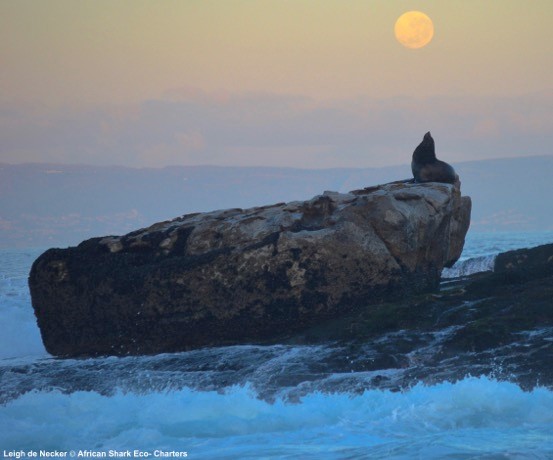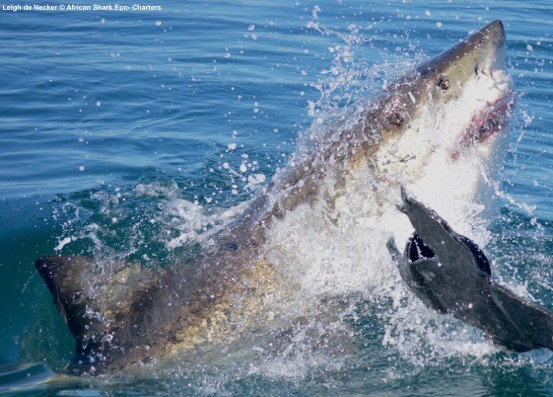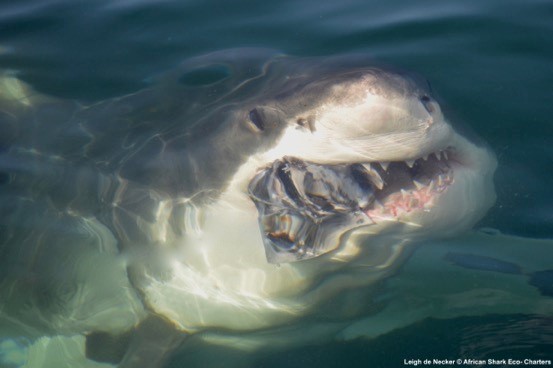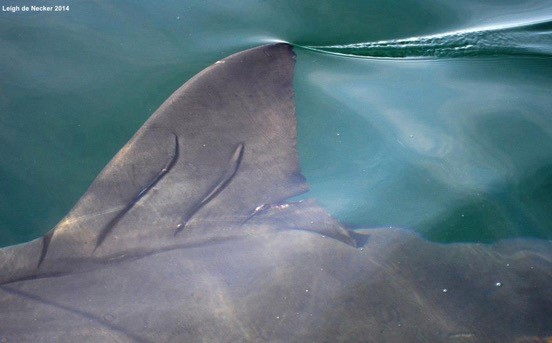News
Summing up the surprises of the 2016 white shark season, Seal Island, False Bay
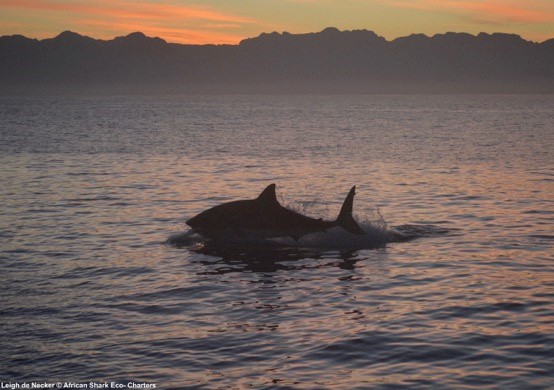
White sharks typically visit False Bay’s Seal Island to take advantage of vulnerable young Cape fur seal pups when they start entering the water to feed. This is generally between March and September; however, this season showed a number of deviations from the expected norms. We took a trip to the Island towards the end of January and before we even had any bait in the water, we had seen a shark. We were beyond excited by the chance of having an early start to the season. This was the first of many unexpected surprises the season had to offer. For February and March, we had amazing shark activity around our boat, seeing an average of 4 sharks a day and still enjoying the late summer, early autumn warm sunny days on the water.
But before we got too comfortable, leaving the sharks to do all our work for us, by the end of April and throughout May, they had simply vanished from Seal Island. There were some really bizarre theories as to where they were and why from crew, clients, fishermen and local shark nuts, but even today the mystery of their temporary disappearance remains. The crew had placed all their bets on the exact date that the sharks would return, and just before we had begun to completely lose our minds (and jobs) the sharks started making an appearance again within the first week of June.
I nearly jumped right off the boat seeing the first shark breach (I always go mad seeing a shark breach, every breach is different and it simply never gets old), but this was a combination of that excitement coupled with relief at the sign that “the shark drought” had potentially come to an end. July was an incredible month with both breaching activity as well as shark activity around the boat. Despite the fact that during this time the sharks were always around, every day, every trip, every hour, in fact, was different. Obviously the breaching and overly enthusiastic sharks around our boat are always a treat, but there were a few really memorable, standout moments this season. Firstly, a shark over 4 m in length, coming fully out of the water attacking a kelp gull just 3 m away from our boat, having the crew and clients very much in the splash zone (this just minutes after I had told a client how breaching was rare in the afternoon, and that I had never seen a shark go for a bird). On another afternoon in July, we had crystal clear waters with over 10 different sharks around our boat, flying at our bait and decoy consistently from all different angles! It was the best kind of chaos!
Further, seeing some of our favourite sharks returning to the boat over consecutive days, a special mention (and thanks) to some of the stars this year: “Zebra,” “Dodgey L,” “Prop,” “Jika,” “Patches,” “Captain MF Hook” “Stumpy Freddy,” “The one with the bent dorsal (Orca/Nemo)” and a few OCEARCH tagged sharks, including “Vindication” and “Maureen.” Of course once we’ve named them, we get very emotionally attached. They become like a puppy dog, really cute but with rather sharp teeth, eating all your personal belongings. When naming and identifying individual white sharks, its usually from a distinguishing feature, scar or behaviour. However, it is incredible to see how much their behaviours’ vary, not only between the different individuals, but even for a particular shark on a particular day. With the number of times I’ve seen a shark put all its effort into the most magnificent breach, only for its targeted seal prey to get away, its not difficult to believe that a shark can have a bad day. Sometimes we’d see sharks hunting and making successful kills still visiting our boat and scavenging at our bait. Surprisingly, and unlike me, sharks don’t seem to have bottomless pits for stomachs, and therefore once they have eaten, they are often uninterested in us, or our bait. Maybe it’s a class thing – why would you eat a stale sandwich when there is fillet steak on offer? It may be more expensive, but totally worth it right?
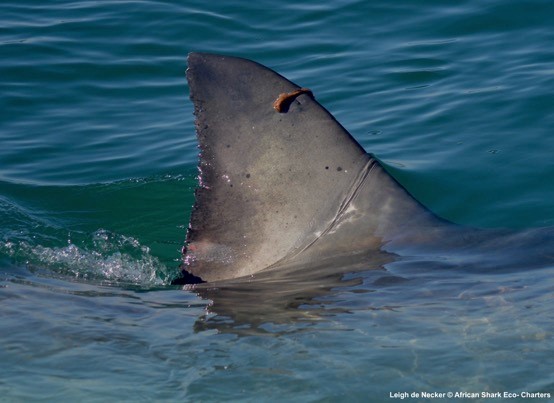
“Captain MF Hook”- I only have a picture of her dorsal fin because she was simply too big to fit in the frame at a massive 5 m in length (we’re going to need a bigger boat).
Another highlight this season was the revisit of the shark “Prop,” named for the propeller scars running along the leading edge and across her dorsal fin. I had first seen her in 2014 when the scars were still fresh and an unmistakable identifying feature. If it weren’t for her stumpy pectoral fin and the fact that she is a particularly large girl, closing in on 5 m, we would not have even recognised her this year. The scars on her dorsal fin had healed up so well being no more than very faint lines across her dorsal fin.
A simple yet perfect example of the perfect predator, proving just how resilient they are and that their ability to heal and recover, is beyond comprehension. There is never a dull moment working with these animals; the more we try to understand them, the more we are left with a whole new set of questions rather than answers. Every day, heading out to Seal Island, you don’t know what you’re going to get. By describing this season as “surprising” “unusual” “unexpected” “unpredictable” is quite appropriate really, because all these words fundamentally define and describe “nature.” If nature were predictable, it would not be as fascinating as it is. To us, what appeared to be “inconsistencies” in the season, served as an important reminder of just how dynamic nature is and it has allowed us to continue marvelling in the mystery that is the white shark.
Leigh is the On-board Marine Biologist for African Shark Eco Charters. Find out more at www.ultimate-animals.com.
Blogs
Get ready for boot Düsseldorf 2025!

Prepare yourself for an unforgettable adventure at boot Düsseldorf, the world’s premier yacht and watersports show. This incredible event draws 214,000 visitors from over 120 countries, showcasing more than 1,500 exhibitors from 67 nations across a staggering 220,000 square meters in 16 exhibition halls.
Whether you’re passionate about diving, yachting, or any water-based activity, this event has something for everyone. From interactive workshops to awe-inspiring showcases, boot Düsseldorf is a must-visit for watersports enthusiasts. Don’t miss out—BUY TICKETS NOW and be part of this extraordinary celebration of life on the water!

Discover the Diving World in Halls 11 and 12
Immerse yourself in the underwater magic of the Diving Halls, where you’ll find everything from trial dives to professional workshops and even insights into the latest equipment and travel destinations. Whether you’re a beginner or an experienced diver, there’s plenty to explore. Don’t miss the centerpiece of the diving area—the Diving Tower, a magnificent structure made of sleek steel and crystal-clear acrylic glass. This engineering marvel provides an unparalleled 360-degree view, making it an unmissable attraction for both participants and spectators. Secure your tickets today—BUY TICKETS NOW!
Try Diving: A First Taste of the Underwater World
Have you ever wondered what it feels like to glide weightlessly through the water? Now’s your chance! Sign up for a trial dive, where professional instructors will guide you step-by-step through the experience.

After a detailed briefing, you’ll take your first plunge into the underwater world in a controlled and safe environment. Whether you’re considering diving as a new hobby or just want to try something exciting, this is your opportunity to make it happen. Spaces fill up fast, so BUY TICKETS NOW to secure your spot!
_____________________________________________________________________________________________
Exhibitor Showcase: DYNAMICNORD
Hall Number: Hall 12 / Stand Number: 12/E60
Email: info@dynamicnord.com / Tel: +49 8061 3898330 / Web: www.dynamicnord.com

The new German diving brand DYNAMICNORD, which presented its product line for the first time at the boot show in 2023, has been entering the British market.
The international team combines extensive experience in the world of diving. DYNAMICNORD produces sustainable, innovative and functional diving equipment: From regulators, computers, BCDs, suits, masks, snorkels and fins to dry suits, bags and accessories. DYNAMICNORD also offers a tech and freediving line as well as a swimwear series.
At DYNAMICNORD the complete team works to reduce the environmental impact in all manufacturing processes. The German R&D department works according to the guidelines and findings of the most important institutions for the protection and sustainability of the environment, at sea and on land.
Raw materials, production methods and locations are chosen carefully. When selecting its suppliers, the team pays attention to full automation, which results in lower electricity and water consumption. 80% of all products are manufactured in Europe.
DYNAMICNORD already recycles all plastic and glass parts of its masks. The inserts of the fin foot pocket are made from PP and TPR waste. The suspension hooks are made from PC waste. Furthermore, DYNAMICNORD supports numerous environmental protection organisations.
Show Offer:
The DYNAMICNORD team is looking forward to presenting the entire product range at the boot show.
During the boot show super bargains can be snapped up – both at DYNAMICNORD dealers and in the online store. There is 20% off the entire range from 18.-27.1.2025.
Furthermore, if you sign up for the newsletter at the DYNAMICNORD stand, you have the chance to an IR-50 regulator worth €499!
All products are available from DYNAMICNORD dealers in UK/Ireland and in the online store. www.dynamicnord.com.
Email: info@dynamicnord.com / Tel: +49 8061 3898330 / Web: www.dynamicnord.com
____________________________________________________________________________________________
Advanced Diving Workshops
For certified divers looking to take their skills to the next level, the advanced workshops in Hall 12 are the perfect choice. Conducted in the state-of-the-art Diving Tower, these sessions are led by seasoned professionals who will help you refine your techniques and gain new insights into the underwater world.

Whether you’re focusing on buoyancy control, underwater navigation, or advanced safety skills, these workshops are an incredible opportunity to grow as a diver. Reserve your place today and ensure you don’t miss out—BUY TICKETS NOW!
Apnoea Diving: Master the Art of Freediving
Dive into the world of apnoea diving, where a single breath takes you on a remarkable underwater journey. This unique discipline combines physical endurance, mental focus, and a deep connection with the water.

Want to get started? The introductory apnoea sessions will teach you the basics, while the Apnoea Workshop offers advanced training for experienced freedivers aged 18 and above. Learn relaxation techniques, breathing exercises, and the essential skills to extend your dive time and explore the depths like never before. Take the plunge—BUY TICKETS NOW!
Mermaiding: Swim Like a Legend
If you’ve ever dreamed of moving through the water like a mermaid, this is your chance! In the Mermaiding sessions, you’ll glide through the water with a large fin, mastering the wave-like movements and breathing techniques needed for this graceful activity.

Under the guidance of qualified instructors, you’ll learn to embody the elegance and fluidity of a mermaid while having a blast. It’s an experience you won’t forget—BUY TICKETS NOW to make it yours!
_____________________________________________________________________________________________
Exhibitor Showcase: Prodivers Maldives
Hall Number: Hall 12 / Stand Number: 12/E68
Email: info@prodivers.com / Web: www.prodivers.com / Social: @prodiversmaldives

35 YEARS OF PRODIVERS!
Prodivers operates a network of dive centers throughout the Maldives, each following the same core philosophy—ensuring that your diving and snorkelling adventures are unforgettable. Each center is designed to cater to the specific needs of the guests visiting each island.
Prodivers Dive Centers are strategically located near the Maldives’ top dive sites. From nearly endless drop-offs and overhangs to gently sloping reefs, from tranquil underwater islands teeming with schools of fish to current-rich channels where large fish roam, Prodivers is fortunate to offer it all!
Explore the reefs of Lhaviyani and South Ari Atolls with PRODIVERS MALDIVES at one of our seven dive centers:
• Kuredu Island Resort
• Komandoo Island Resort
• Lily Beach Resort & Spa
• Hurawalhi Island Resort
• Kudadoo Private Island
• Innahura Maldives Resort
• Jawakawa Islands Maldives
SUMMER SPECIAL OFFER**
• 15% OFF for all divers
• 25% OFF for groups (minimum of 6 divers)
*Offer valid from May 1 to October 1, 2025
*Email us to claim your discount
35 JAHRE PRODIVERS!
Prodivers betreibt Tauchzentren auf den Malediven, jedes mit der gleichen Philosophie – sicherzustellen, dass Ihre Tauch- und Schnorchelerlebnisse so gut wie möglich sind. Jedes Zentrum ist speziell auf die Bedürfnisse der Gäste abgestimmt, die jede der Inseln besuchen.
Die Prodivers Tauchzentren befinden sich in unmittelbarer Nähe der besten Tauchplätze der Malediven. Von fast bodenlosen Abhängen mit Überhängen bis zu sanft abfallenden Riffen, von geschützten Unterwasserinseln, die Zufluchtsorte für schwimmende Fische sind, bis zu Kantrandbereichen, in denen Strömungen rasant sind und große Fische umherziehen – bei Prodivers haben wir großes Glück – wir haben alles!
Entdecken Sie die Riffe der Lhaviyani- und Süd-Ari-Atolle mit PRODIVERS MALDIVES in einem unserer sieben Tauchzentren:
• Kuredu Island Resort
• Komandoo Island Resort
• Lily Beach Resort & Spa
• Hurawalhi Island Resort
• Kudadoo Private Island
• Innahura Maldives Resort
• Jawakawa Islands Maldives
SOMMER-SPECIAL**
15% RABATT FÜR ALLE TAUCHER
25% RABATT FÜR GRUPPEN (MIN. 6 TAUCHER)
*Gültig vom 1. Mai bis 1. Oktober 2025
*Emailen Sie uns, um Ihren Rabatt zu aktivieren
_____________________________________________________________________________________________
The Spectacular New Diving Tower
A true highlight of boot Düsseldorf, the Diving Tower is a masterpiece of design and functionality. Standing tall with a diameter of eight meters and a height of four meters, this massive structure holds 200,000 liters of water and offers spectators a full 360-degree view of the action inside.

Introduced in 2023, this impressive feature, designed by architect Jürgen Sütterlin, has quickly become a centerpiece of the show. Whether you’re participating in workshops or simply enjoying the view, the Diving Tower is a must-see attraction. Find it in Hall 12, where it’s surrounded by interactive activities and workshops for divers of all skill levels. Don’t miss the chance to experience this marvel up close—BUY TICKETS NOW to be part of the action!
Capture the Magic at Water Pixel World in Hall 11
For photography and film enthusiasts, Water Pixel World is the ultimate destination. Whether you’re a beginner or a seasoned pro, you’ll find a wealth of resources to help you capture the beauty of underwater life and watersports.

From expert-led talks to hands-on demonstrations, this area offers everything you need to elevate your skills. Discover the latest photography and videography equipment, gain insights from professional photographers, and witness breathtaking visuals on the Water Pixel World stage.
Highlights from the Speaker Lineup
- Adrian Mattern: Learn how to capture the excitement of whitewater action sports through photography.
- Tobias Friedrich: Gain professional tips for underwater photography using SeaLife cameras to create stunning images.
- Peter Löseke: Explore the art of finding the perfect angles to capture marine life in its full glory.
If you’re passionate about documenting your underwater adventures, Water Pixel World is not to be missed. Upgrade your skills and gear—BUY TICKETS NOW to join the fun!
Don’t Miss Boot Düsseldorf 2025!
From diving and photography to mermaiding and freediving, boot Düsseldorf offers an incredible array of experiences for watersports lovers. With world-class exhibits, hands-on activities, and awe-inspiring attractions, it’s an event like no other. Be part of the magic—BUY TICKETS NOW and secure your spot at boot Düsseldorf 2025!
Visitor hotline: +49 211 4560-7640
email: info@messe-duesseldorf.de
Blogs
Explore the Wonders of the Coral Triangle with Buceo Anilao Beach and Dive Resort

Welcome to Buceo Anilao, a haven for divers nestled in the heart of the Coral Triangle. Immerse yourself in the perfect blend of relaxation and the renowned hospitality of the Filipino people.

Our lush gardens and premium amenities provide a sanctuary of tranquillity amidst nature’s beauty. Surround yourself with artistry and serenity, complemented by the vibrant colours of our resort.

Retreat to one of our 23 spacious and inviting rooms, each designed to provide a clean and relaxing environment, ensuring you are well-rested for the exciting diving activities that await.
The buffet breakfast and à la carte menu offer a wide range of appetising dishes, featuring a delightful fusion of local flavours and international cuisine.

At Buceo Anilao, we cater to every taste, making dining an integral part of the experience.

Get ready to explore the depths with confidence, thanks to our well-maintained equipment and knowledgeable staff. Our camera room is a sanctuary for underwater photographers, providing the perfect space to prepare and care for your gear.

Your safety is paramount. Trust our local dive masters to guide you through each dive, ensuring a seamless and enriching experience. Elevate your expertise with our diverse range of courses designed to enhance your diving skills.
Dive into a haven for macro photography, where every dive unveils a kaleidoscope of marine treasures. Encounter countless underwater species, from vibrant nudibranchs to elusive Rhinopias, amidst stunning coral reefs, muck sites, and other diverse underwater landscapes.
Elevate your diving experience with mesmerising night dives! Encounter rare marine wildlife for an unforgettable adventure.
Relax after your activities with a treatment in our spa, where therapeutic massage sessions and panoramic views provide the perfect way to unwind after your underwater adventures.
As the day winds down, enjoy a relaxed sunset session. Revel in the magic of Buceo Anilao with stunning views and refreshing drinks, concluding another memorable day in our diver’s paradise.

No need to travel far! Buceo Anilao is conveniently located near Manila International Airport, just a short 2.5-hour drive to one of the best macro photography destinations in the world. This is the top choice for underwater photographers who value diversity, convenience, and the ultimate resort experience! 😊

For bookings, email us at contact@buceoanilao.com or visit our website and social media accounts for more information:
Website: www.BuceoAnilao.com
Facebook: www.Facebook.com/buceoanilao
Instagram: www.instagram.com/buceoanilao
-

 News3 months ago
News3 months agoIconic SS United States to become the World’s Largest Artificial Reef
-

 Blogs2 months ago
Blogs2 months agoScubaverse Christmas Gift Guide 2024: Day 4
-

 News2 months ago
News2 months agoSanta Divers take the Plunge for Charity
-

 Blogs2 months ago
Blogs2 months agoScubaverse Christmas Gift Guide 2024: Day 1
-

 News3 months ago
News3 months agoDiscover Turquoise Divers and Media Luna Beach & Dive Resort: A Premier Diving and Relaxation Destination in Roatan
-

 Blogs2 months ago
Blogs2 months agoScubaverse Christmas Gift Guide 2024: Day 5
-

 Blogs2 months ago
Blogs2 months agoScubaverse Christmas Gift Guide 2024: Day 2
-

 News3 months ago
News3 months agoToucan Diving at Plaza Beach and Dive Resort Bonaire Introduces PADI Mermaid Training



